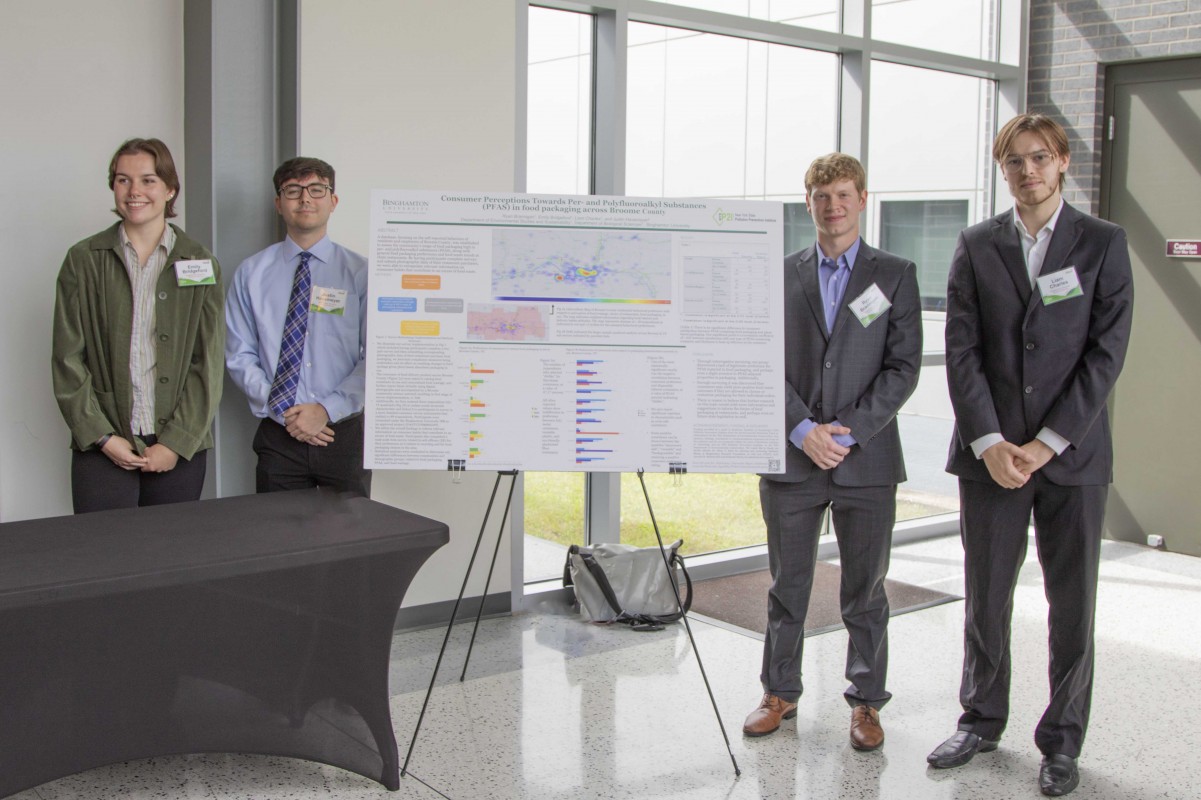Citizen science: Do you know whether your takeout has potentially dangerous chemicals?
Environmental science research explores consumer interest in PFAS-free food packaging

You’re hungry after a study marathon and decide to grab a quick burrito.
What you may not know: that crinkly wrapper may contain per- and polyfluoroalkyl substances (PFAS), termed “forever chemicals” because they don’t break down in the environment or our bodies. And PFAS carry significant potential health risks, with links to high cholesterol, higher rates of testicular and kidney cancer, liver damage and thyroid disease, among other conditions.
This summer, a Binghamton University research team under the direction of Environmental Studies lecturer Nirav Patel explored community perceptions and behavioral attitudes regarding PFAS as part of Keep It Fresh!, the New York State Pollution Prevention Institute’s first Student and Faculty Research Program. The institute launched the program early this year when it challenged graduate and undergraduate students from participating universities to research topics related to food packaging.
Students participating in the fully paid internship included Liam Charles, a master’s student in sustainable communities; Emily Bridgeford, a senior environmental science major; Justin Havemeyer, a senior biological science major; and Ryan Brannigan, a senior environmental studies major.
“We know there’s a problem with the food waste from restaurants and a problem with contaminants from food packaging options,” Charles said. “And we know that these two issues are relevant to both food production and food distribution. Where’s the balance? Is there a legitimate reason that people should be exposed to these chemicals, such as limiting food waste? Or can we find a rationale to pressure companies to phase them out?”
Each team member brought their own perspective to the project: Charles is interested in how people use urban spaces and Brannigan in law and policy; the latter was also instrumental in the GIS mapping used in the study. Bridgeford, with interests in food justice, is involved with Binghamton’s downtown farmers market. Havemeyer works at a local hospital and plans to become a physician assistant.
“Using a research methodology known as citizen science, our project concluded that consumers could force changes up the supply chain,” Patel said.
PFAS and consumer choice
The purpose of PFAS in food containers is to prevent spoilage, which means the chemicals could work to prevent food waste, Brannigan acknowledged. But would consumers prefer cardboard or fiber packaging if they knew the health risks?
The team began with a literature review on PFAS, their potential health impacts and state legislative policy regarding the substances, Bridgeford said. They also gathered a list of restaurants to contact about their choice of food packaging and formulated surveys that were distributed to Binghamton students. That last required some recruitment, in the form of posters, word-of-mouth and a gift card as compensation.
Only 20% of students surveyed knew anything about PFAS, Charles said. That’s probably higher than the general population, considering that survey takers likely included Environmental Studies majors.
“Even a lot of those people probably didn’t know that it was in their fast food,” he said.
The team also mapped the pattern of food containers in and around Binghamton, with an eye to tracking any connection between food waste and PFAS-free packaging. They didn’t have enough data to answer their original research question, about whether PFAS helps mitigate potential food waste by keeping food fresh longer. However, they did discover that consumers had mixed preferences; 70 percent wanted access to eco-friendly options, but they also wanted packaging to keep food fresh.
“Nobody wants Styrofoam packaging anymore, but, at the same time, no one wants packaging that’s not useful for the purpose of reheating the food,” Brannigan said.
Fiscal realities are also an issue. Populations that are strapped for resources — students included — might opt for quick, cheap take-out rather than a homecooked meal, even if they know the health risks, Charles pointed out.
During the course of their research, the students learned how to identify plastic types by the small identification number on the bottom of take-out containers. And yes, when they grab a quick bite somewhere, they do check whether their food packaging contains PFAS … sometimes.
“One of the difficult things about being an environmental studies student is that I know so much about the problems there are and the choices we can make as consumers every day,” Bridgeford reflected. “But sometimes, you need to find a balance between making informed choices and living your life, for the sake of your own sanity.”

